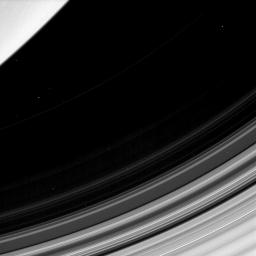
|
Dusty D Ring
- Click the image above for a larger view
- Full-Res JPEG (1020 x 1020) (88.2 kB)
- Full-Res TIFF (1020 x 1020) (1.0 MB)
Caption:
Saturn's D ring is easy to overlook since it's trapped between the brighter C ring and the planet itself. But this dusty ring has plenty to teach us. In this view, all that can be seen of the D ring is the faint and narrow arc as it stretches from top right of the image.
If all goes as planned, Cassini will pass between the D ring and Saturn in its final orbits in 2017. Scientists expect to gather unprecedented data from these orbits.
Also visible in this image are 12 stars.
This view looks toward the unilluminated side of the rings from about 41 degrees below the ringplane. The image was taken in visible light with the Cassini spacecraft narrow-angle camera on Oct. 21, 2013.
The view was obtained at a distance of approximately 1.5 million miles (2.4 million kilometers) from Saturn and at a Sun-Saturn-spacecraft, or phase, angle of 140 degrees. Image scale is 8.7 miles (14 kilometers) per pixel.
Background Info:
The Cassini-Huygens mission is a cooperative project of NASA, the European Space Agency and the Italian Space Agency. The Jet Propulsion Laboratory, a division of the California Institute of Technology in Pasadena, manages the mission for NASA's Science Mission Directorate, Washington, D.C. The Cassini orbiter and its two onboard cameras were designed, developed and assembled at JPL. The imaging operations center is based at the Space Science Institute in Boulder, Colo.
For more information about the Cassini-Huygens mission visit http://saturn.jpl.nasa.gov and http://www.nasa.gov/cassini . The Cassini imaging team homepage is at http://ciclops.org .
Cataloging Keywords:
| Name | Value | Additional Values |
|---|---|---|
| Target | Saturn Rings | D Ring, Saturn |
| System | Saturn | |
| Target Type | Ring | Planet |
| Mission | Cassini-Huygens | |
| Instrument Host | Cassini Orbiter | |
| Host Type | Orbiter | |
| Instrument | Imaging Science Subsystem (ISS) | |
| Detector | Narrow Angle Camera | |
| Extra Keywords | Dust, Grayscale, Visual | |
| Acquisition Date | ||
| Release Date | 2014-02-24 | |
| Date in Caption | 2013-10-21 | |
| Image Credit | NASA/JPL-Caltech/Space Science Institute | |
| Source | photojournal.jpl.nasa.gov/catalog/PIA17150 | |
| Identifier | PIA17150 | |
